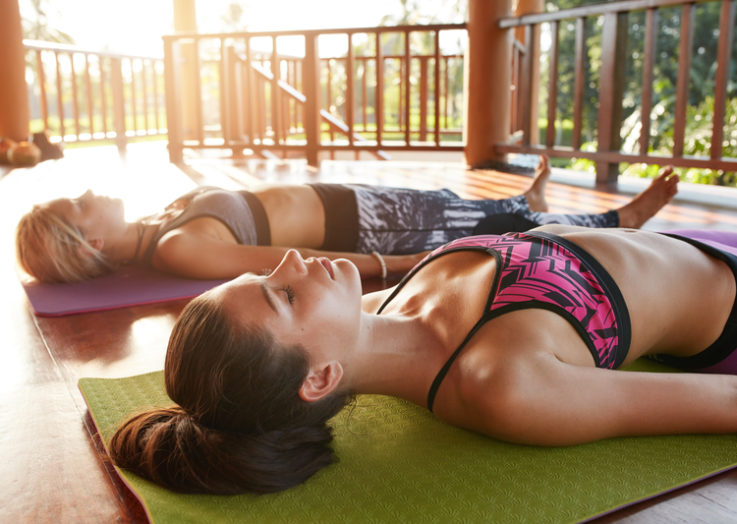If you experience anxiety, you may not know how to best deal with it. Perhaps you’ve tried meditation, muscle relaxation, deep breathing, and regular exercise, and they likely have helped. But have you ever thought of using yoga for anxiety?
Well, if you haven’t had that thought before, you should! Not only is yoga a great way to tone up, gain flexibility, and relieve pain, it’s been shown to be helpful when it comes to reducing stress, anxiety, and even depression.
Yoga is comprised of two main components: physical movement and breathing techniques. These two activities combine to form a potent anxiety-busting formula.
How Does Yoga Help to Relieve Anxiety?
Yoga is well known for helping to reduce stress and anxiety for a variety of reasons.
Yoga helps you learn to breathe deeply—according to the Lung Institute, doing pranayama yoga can help reduce stress. Pranayama is a form of yoga which uses various forms of breathing to help clear and reduce physical and emotional blockages from our bodies.
Yoga makes you focus on your body—yoga removes your ability to concentrate on your problems. Since you can focus only on one thing at a time, and yoga poses force you to think about what you’re doing physically in the moment, you tend to forget about your issues at least temporarily.
Yoga reduces stress markers—according to the Harvard Medical School, studies show that the practice of yoga has the power to modulate the stress response. This occurs by reducing the amount of stress you seem to feel. Because the poses require deep breathing, gentle stretching, and often some form of meditation, those who practice yoga can find their heart rates naturally slow down, blood pressure is reduced, and they are able to breathe more deeply. These are all actions which help reduce overall stress and anxiety and help deal with depression.
Researchers even went as far as to note that those who practice yoga may have a relatively higher pain tolerance than those who do not. The calming effects of yoga are scientifically proven and can be harnessed to effectively combat anxiety.
6 Yoga Poses That Help Reduce Anxiety
Using yoga for anxiety is truly helpful because in order to perform the movements correctly, and to get the most out of each pose, it’s crucial that you focus on your physical body and not any erroneous or stressful thoughts circulating in your head or even what’s going on in your surrounding environment.
1. Tree Pose
This yoga pose requires you to clear your mind and focus on the task at hand. Since you’re using opposing forces to balance your body, it’s critical that you pay attention to what you’re doing, physically, to stay upright.
Begin by standing with your feet hip-width apart. Raise your arms out to the sides and then, while keeping your arms straight, press your palms together directly above your head. Next, take your right foot and place it flat against your left inner calf and slide your foot upwards to place it on your thigh. (Just remember to not place it against the knee.) Hold this pose for a few moments and then slide your foot back to the starting position and repeat the balance on the opposite leg.
2. Legs on Wall
This pose helps relieve the stress and tension you carry around with you all day as you walk around upright. Using this pose may help rejuvenate your circulation. The act of simply placing your legs above your head and heart serves to help relax and calm your mind and body.
You may want to lie on a mat or even a pillow to perform this pose. Begin with your legs to one side and bring your hips and buttocks right up against the wall. Lift your legs up the wall until they are straight and perpendicular to the floor. Stay in this pose and breathe in slowly for a count of five and out slowly for a count of five. Repeat for as long as you like or until you feel centered and calm.
3. Child’s Pose
This pose can help reduce stress by fostering better circulation, relaxation for the front of your body, a gentle stretch for your shoulders and back muscles, and a release of tension in the hips.
Begin on your hands and knees. Lean forward and stretch your arms out straight in front of you as far as you can. Drop your hips back onto your heels and feel the stretch throughout your body. If it’s more comfortable, separate your knees and let your body rest between your legs. And if this is too intense for your shoulders, you can gently rest your forehead on a block or even a firm pillow. Breathe deeply as you relax and let the stress go.
4. Supported Shoulder Stand
Not a full headstand, this easier version of placing your feet in the air can literally help relieve stress by bringing blood flow and nourishment back to your head and by changing your perspective (because you’re virtually looking at the world from a different angle).
Begin this inversion pose by lying on your back with your legs out straight. Place your hands under your hips for support and bring your hips up and lift your legs up until they are perpendicular to the ground. Remain in this position while you breathe deeply and allow your mind to clear and your heartrate to slow.
This can be a difficult and intense pose. Fortunately, there are a few modifications that can make it more accessible. The first is to place your hips on 1 or 2 blocks. It allows you to get familiar with inversion poses even if your body is not ready to come all the way up or on those days you want to take it a bit easier. Start by laying on your back with legs bent and your feet directly under your knees. Lift up your hips into bridge pose, and place one or two blocks on their flattest, lowest side directly under your sacrum. Lower your hips onto the blocks, so they’re elevated. Then straighten your legs above you, perpendicular to the ground, and relax and breathe.
You can also perform a full shoulder-stand with your legs supported on a wall.
Finally, you can place folded blankets or towels under your shoulders, so your head can be a bit lower than your shoulders as you perform a full shoulder-stand.
Whichever variation you choose, start slowly and where you feel comfortable, and progress from there.
5. Chanel-Cleaning Breath Pose
This type of yoga breathing is used to help calm anxiety and stress and is even recommended by the Lung Institute to help patients regain control, feel more relaxed, and stabilize blood pressure.
This type of practice is a preparation for more intensive yoga moves and is also called “alternate-nostril breathing.” Because your breath controls so much related to your body, mind, and mood, harnessing the power of your breath is helpful when it comes to reducing anxiety. Sit comfortably on the floor with your legs crisscrossed. You’ll want to keep your spine in a neutral position, so you may want to sit up on a folded blanket, pillow, or yoga block. With your right thumb, gently press on your right nostril to close it. Breathe in through your left nostril and then use your finger to close that and allow the right nostril to open so you can exhale. Repeat on the opposite side, keeping the left nostril closed and inhaling through the right side. Close that side and exhale through your left. Repeat five times.
6. Corpse Pose
This morbid-sounding pose is actually the one that offers the best relaxation benefits of them all. Lie on your back on a mat with your legs out straight, yet relaxed, and your arms down by your sides. Your head should be neutral. Just close your eyes and breathe in and out deeply for up to ten minutes. It’s almost impossible not to relax and feel a sense of calm come over you while you are in this pose.
You can practice these poses anytime you feel anxious, yet to help prevent feeling that way in the first place, you may benefit from a regular yoga practice. Some choose shorter daily sessions (for around 10 to 15 minutes per day). Others choose longer sessions a couple of times a week. Either way, by combining breathwork with physical movements, you may enjoy potent anxiety relief.









